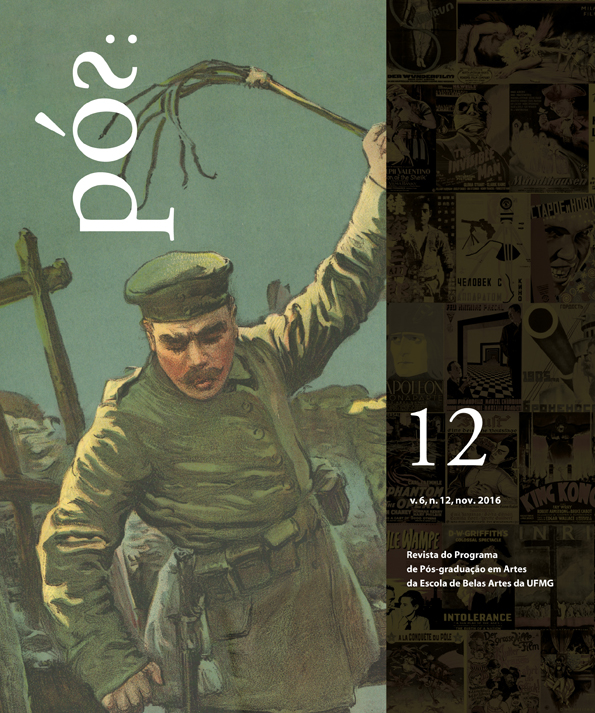CHANBARA
HISTÓRIA E HONRA NO CINEMA DE SAMURAI JAPONÊS
DOI:
https://doi.org/10.35699/2238-2046..15745Palavras-chave:
Cinema, Japão, Samurai.Resumo
O filme de samurai é um importante gênero na cinematografia japonesa, estando presente nas películas desse país durante toda a história da arte cinematográfica do Japão. Esse artigo trata do filme de chanbara, nome pelo qual o filme de samurai é conhecido em seu local de origem. No texto são abordadas as características e a história desse gênero cinematográfico no Japão desde seu início no final do século XIX até os dias atuais. Objetiva-se com esse estudo obter uma maior compreensão desse gênero e de suas peculiaridades.
Downloads
Referências
ANDERSON, Joseph L.; RICHIE, Donald. The Japanese Film – Art and Industry, New Jersey: Princeton University Press, 1982. p. 440-443.
BERRA, John. Directory of World Cinema Japan, Bristol: Intellect, 2010.
BORDWELL, David. Ozu and the Poetics of Cinema, New Jersey: Princeton University Press, 1988. p. 17-30.
FERIBERG, Freda. Utamaro and his Five Women. In: Senses of Cinema, 2003. Disponível em: http://sensesofcinema.com/2003/cteq/utamaro/>. Acessado em: 15 jun. 2015.
GORDON, Andrew. A Modern History of Japan: From Tokugawa Times to the Present, Oxford: Oxford University Press, 2003. p. 9-11; 161-162.
KAKESHI, Hisao; TAMORI, Ikuhiro; SCHOURUP, Lawrence. Dictionary of Iconic Expressions in Japanese: Volume I: A – J , New York: Mouton de Gruyter, 1996.
MCDONALD, Keiko I. Japanese Classical Theater in Films, Toronto: Associated Unversity Presses, 1994.
MES, Tom; SHARP, James. The Midnight Eye Guide to New Japanese Film, California: Stone Bridge Press, 2005. p. 158-171; 180-196.
HOWE, Justin. Chambara / Samirai Cineam. In: BERRA, John. Directory of World Cinema Japan, Bristol: Intellect, 2010. p. 84-87.
NAGIB, Lúcia. Nascido das Cinzas – Autor e Sujeito nos Filmes de Oshima, São Paulo: Editora da Universidade de São Paulo, 1995. p. 145-163.
NAITO, Takashi; GIELEN, Uwe. Tatemae and Honne: A Study of Moral Relativism in Japanese Culture. In: GIELEN, Uwe; ADLER, Leonore; MILGRAN, Norman, Psyvhology in International Perspective: 50 Years of the International Council of Psychologists, Amsterdan: Swets & Zeitlinger, 1992.p. 163-134.
RICHIE, Donald. Japanese Cinema: Film Style and National Character, New York: Anchor Books, 1971.
_______. A Hundred Years of Japanese Cinema, Tokyo: Kodansha, 2005.
THORNE, Roland. Samurai Films, England: Kamera Books, 2008.
THORNTON, S. A. The Japanese Period Film: A Critical Analysis, North Carolina: McFarland & Company, Inc., 2008.
WADA-MARCIANO, Mitsuyo. Nippon Modern – Japanese Cinema of the 1920s and 1930s, Honolulu: University of Hawai’I Press, 2008.
Downloads
Publicado
Edição
Seção
Licença
Copyright (c) 2016 Marcelo Dídimo Souza Vieira, Jorge Couto de Alencar

Este trabalho está licenciado sob uma licença Creative Commons Attribution-NonCommercial 4.0 International License.
Autores que publicam nesta revista concordam com os seguintes termos:
- Autores mantém os direitos autorais e concedem à revista o direito de primeira publicação, com o trabalho simultaneamente licenciado sob a Creative Commons Attribution-NonCommercial 4.0 International License que permite o compartilhamento do trabalho com reconhecimento da autoria e publicação inicial nesta revista.
- Autores têm autorização para assumir contratos adicionais separadamente, para distribuição não-exclusiva da versão do trabalho publicada nesta revista (ex.: publicar em repositório institucional ou como capítulo de livro), com reconhecimento de autoria e publicação inicial nesta revista.
- Autores têm permissão e são estimulados a publicar e distribuir seu trabalho online (ex.: em repositórios institucionais ou na sua página pessoal) a qualquer ponto antes ou durante o processo editorial, já que isso pode gerar alterações produtivas, bem como aumentar o impacto e a citação do trabalho publicado
- É responsabilidade dos autores a obtenção da permissão por escrito para usar em seus artigos materiais protegidos por lei de Direitos Autorais. A Revista PÓS não é responsável por quebras de direitos autorais feitas por seus colaboradores.












